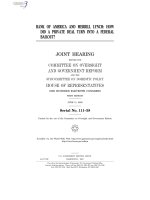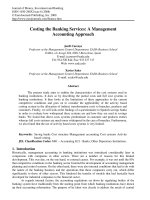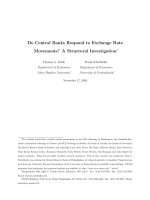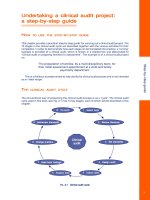Good Practice Guidance Delivering Audit Assignments: A Risk-based Approach potx
Bạn đang xem bản rút gọn của tài liệu. Xem và tải ngay bản đầy đủ của tài liệu tại đây (201.53 KB, 24 trang )
Good Practice Guidance
Delivering Audit Assignments:
A Risk-based Approach
November 2005
Good Practice Guidance
Delivering Audit Assignments:
A Risk-based Approach
November 2005
© Crown copyright 2004
Published with the permission of HM Treasury on behalf
of the Controller of Her Majesty’s Stationery Office.
The text in this document (excluding the Royal Coat of
Arms and departmental logos) may be reproduced free of
charge in any format or medium providing that it is
reproduced accurately and not used in a misleading
context. The material must be acknowledged as Crown
copyright and the title of the document specified.
Any enquiries relating to the copyright in this document
should be sent to:
The Licensing Division
HMSO
St Clements House
2-16 Colegate
Norwich
NR3 1BQ
Fax: 01603 723000
E-mail:
HM Treasury contacts
This document can be accessed from the Treasury
Internet site at:
www.hm-treasury.gov.uk
For further information on the Treasury and its work,
contact:
Correspondence and Enquiry Unit
HM Treasury
1 Horse Guards Road
London
SW1A 2HQ
Tel: 020 7270 4558
Fax: 020 7270 4861
E-mail:
Delivering Audit Assignments: A Risk-based Approach
1
CONTENTS
Page
Chapter 1 Introduction
3
Chapter 2 The Audit Environment
5
Chapter 3 The Audit Process
7
Annex A Glossary of Key Terms
19
Delivering Audit Assignments: A Risk-based Approach
3
1.1 This guide provides good practice guidance in support of Government Internal
Audit Standard 7 – Management of Audit Assignments, with the objective of providing a
description of the processes and issues to be considered during the planning, conduct
and management of audit assignments. This guide has been prepared primarily to
support the conduct of assurance assignments, which contribute to the annual audit
opinion, but the generic principles are applicable to all assignments likely to be
conducted by Internal Audit.
1.2 This guide also provides good practice guidance to improve the likelihood of
successful delivery of audit objectives through awareness and management of risks
specific to audits and, as a consequence, is addressed primarily to people who
undertake audit assignments themselves.
1.3 This guide does not seek to replicate previously issued good practice guidance
on Audit Strategy but assumes that audit assignments take place in a context of risk-
based internal auditing, i.e. in an environment where auditors use analyses of inherent
and residual risk to direct their work.
1.4 Definitions of key terms are included in the Glossary at Appendix B.
1
INTRODUCTION
Delivering Audit Assignments: A Risk-based Approach
5
2.1 The quality of audit assignments, the personal development of internal audit
team members, efficiency and the credibility of internal audit are all enhanced by and
dependent on the following:
x clear lines of reporting and advice, including supervision and mentoring;
x clearly understood standards of conduct and ethics;
x access to specialist knowledge where relevant;
x ongoing audit team-level risk management;
x the support of senior management, the Accounting Officer and the Audit
Committee;
x knowledge-sharing and in-team communications;
x liaison with external auditors and other assurance providers;
x training, development and staff evaluation processes;
x succession planning;
x a shared focus on continuous improvement;
x regular communications with senior management, the Accounting Officer
and the Audit Committee; and
x clearly defined quality assurance and authorisation procedures.
2.2 Every audit team should also put in place appropriate local standards and
practices to provide evidence of the approach that has been adopted.
2
T
HE AUDIT ENVIRONMENT
Delivering Audit Assignments: A Risk-based Approach
7
3.1 Below is an overview of the Audit Process at assignment level that is explained in
more detail in the following subsections.
3
THE AUDIT PROCESS
Overview o
f
the Audit
Process
3 T
HE
A
UDIT
P
ROCESS
8
Delivering Audit Assignments: A Risk-based Approach
3.2 Risks and controls can only be properly understood in the context of ongoing
operations, so you should ensure you have at least a high-level and up to date
understanding of the objectives and operational environment of the business area
under review (and hence of the key business risks and controls) at the outset of your
work.
3.3 For example, you should enquire about significant recent or planned
organisational changes and about the management structure. This is essential for
managing sensitivities as well as for planning your work and as a basis for making
appropriate judgements and recommendations.
3.4 Your understanding of the business area and of its risk profile will continue to
develop throughout the assignment and you should always consider whether new
information should affect decisions and judgements already made.
3.5 The objective of each audit assignment should be clearly documented in all
cases and should support Internal Audit’s primary objective to provide an independent
and objective opinion to the Accounting Officer on risk management, control and
governance.
3.6 Other generic, underlying objectives for each assignment are likely to include:
x compliance with the Government Internal Audit Standards including due
professional care requirements;
x development of ongoing effective working relationships with clients at all
levels;
x the training and development of Internal Audit staff; and
x the development of the Audit function within the organisation.
3.7 Risks to the delivery of the objectives of the particular audit assignment and to
strategic underlying objectives (Audit Risks) will arise during the course of every
assignment.
3.8 You should consider and document key Audit Risks and relevant action plans at
the outset of an assignment and should actively manage those risks throughout the
assignment. Documentation of Audit Risks (as opposed to documentation of the risks
being audited) is needed to demonstrate due professional care over the conduct of an
audit assignment, as would be expected of any other project. However, the level of
documentation should be appropriate to the scale and risk of the assignment.
3.9 Risk management actions initiated by this process might include: adjusting the
composition or resource allocations of the audit team, consciously focusing on
relationship management, alerting other stakeholders to the proposed assignment or
introducing additional review procedures. There are also opportunities to
communicate risks to auditees and enlist their support in audit risk management.
3.10 When documenting Audit Risks it is particularly important that you should, in
coordination with the Head of Internal Audit or his or her delegate, consider the
importance of the assignment in the context of its significance to the overall audit
opinion for the year.
Understandin
g
the relevant
part of the
business
Audit
objectives
Audit risks
T
HE
A
UDIT
P
ROCESS
3
Delivering Audit Assignments: A Risk-based Approach
9
3.11 You should meet client management during scoping to ensure that you have a
common understanding of the relevant processes, risks, controls and business
conditions and to discuss how you will work together during the audit to achieve the
best results.
3.12 Client management involvement in scoping assignments is crucial to ensure
that you both understand the reason for performing the audit. It is also an opportunity
to discuss what you will require / expect of each other and to plan communications and
fieldwork effectively.
3.13 You should also discuss at the outset any specific requirements for providing
assurance in greater depth than normal to address specific risks, e.g. in the case of
known allegations against individuals or where there is a history of poor controls.
Examples of Audit Risks
Could you prevent any of these generic audit risks impacting on your assignment?
x key risks are not identified or key controls are not properly tested, meaning that key issues
are missed or a wrong opinion is given because of lack of the right skills, experience,
supervision or specialist expertise
x the audit is scoped too widely / loosely, leading to failure to meet resource and
timeframe targets / to address the issues on a timely basis
x real or perceived conflicts of interest impair audit objectivity and undermine the results of
the audit
x audit work is performed in insufficient depth to meet specific management
expectations or concerns
x audits are unable to progress or audit findings are not acted on because of lack of senior
management support and buy-in
x key audit staff becoming unavailable at short notice (e.g. long-term sick, resignation)
x audits duplicate the work of other assurance providers, wasting audit and client
resources
x lack of progress or failure to escalate on a timely basis means findings become out of date
before the audit is completed
x access to third parties or to key people or documents is not granted, meaning that prior
work is wasted
x the audit team may be deliberately misled
x client relations are damaged because management sensitivities are not properly handled,
there are personality clashes between auditors and management or because management do
not feel properly involved / consulted
x there are missed opportunities for improving client relationships and the reputation of
Internal Audit or for identifying follow on audit or consultancy requirements
Scoping and
plannin
g
3 T
HE
A
UDIT
P
ROCESS
10
Delivering Audit Assignments: A Risk-based Approach
3.14 A scoping document should be agreed with client management and circulated
to all interested parties that clearly sets out:
x the assignment objectives;
x assignment scope and any limitations of scope;
x assignment approach and methodology;
x nature of draft and final deliverables and distribution;
x expectations of client management;
x key forecast dates;
x assignment team members and quality assurer or line manager; and
x assignment sponsor.
3.15 Evidence of approval by the sponsor and the Head of Internal Audit or the Head
of Internal Audit's delegate should be retained.
3.16 The scope of work should always include assessment of whether objectives are
congruent with higher level corporate objectives and evaluation of management's own
risk analysis and risk management processes.
3.17 The audit objectives and approach should be reconsidered regularly throughout
the assignment and should be adjusted, after agreement with management, if
appropriate.
3.18 A team with the right mix of experience, specialist knowledge and skills should
be selected and responsibility for leading the team and for delivering a successful
outcome should be clear to both the audit team themselves and the sponsor. Sources
of specialist skills outside the internal audit team should be considered if appropriate,
e.g. potential partnerships with outsourced providers or with operational staff with
relevant technical skills.
3.19 A time and expenses budget should be agreed for the assignment, including
allocating the time to be incurred on each part of the assignment.
T
HE
A
UDIT
P
ROCESS
3
Delivering Audit Assignments: A Risk-based Approach
11
Examples of planning issues
x Are specialist skills available if required (e.g. Information Technology, Statistics, Actuarial)?
x Are adequate continuity plans in place to cover the loss of key audit personnel during the
audit assignment?
x Are there any limitations of scope? Are these acceptable, documented and agreed with
client management before fieldwork begins?
x Has an appropriately senior sponsor been identified for the assignment and has that
sponsor agreed to buy in to the process?
x Have all appropriate interested parties been informed of the review’s objectives, timings
and proposed approach?
x Have all timing restrictions been identified and addressed (e.g. of key people or systems)?
x Has any required access to third parties been obtained?
x Are the distribution lists for deliverables clear?
x Are assignment team members sufficiently experienced and skilled to perform the work or
have appropriate mentoring arrangements been made to address any skill / experience
gap?
x Does the proposed approach fully meet the audit assignment’s objectives?
x Have the audit assignment’s objectives, scope and approach been clearly documented and
agreed with client management, including the sponsor?
x Is there any known ground for concern that means that audit testing should be performed
in more detail than usual in this case?
x Is there any overlap between this assignment and other assurance (e.g. internal or external
audit) work that could be exploited?
x Are there any conflicts of interest in the audit team or with client management that
should be addressed or monitored?
x Are there any opportunities to add more value through the audit process?
x Are there any signs or is there any history of management non-cooperation / lack of
buy-in that should be considered at this point?
x Is the audit resource budget adequate or over-generous, considering the risk of the
processes to be reviewed?
x Does the audit resource budget make provision for management review / quality
assurance, for travel time and expenses and for training and supervision needs?
x Is the assignment so high profile or so important to the Head of Internal Audit's overall
opinion on risk management, governance and control that additional supervision or review is
needed?
3 T
HE
A
UDIT
P
ROCESS
12
Delivering Audit Assignments: A Risk-based Approach
3.20 A preliminary understanding of the relevant risks and controls will have driven
inclusion of the assignment in the Head of Internal Audit’s Annual or periodic Plan.
However, the objectives of the management unit(s) and their relation to the higher-level
objectives of the organisation generally should be confirmed, and the risks to these
objectives and to the objectives of the organisation as a whole should also be
understood. This may be achieved through discussions with management, through
consideration of previous audit work, through risk workshops and through review of
relevant documentation.
3.21 The adequacy of the process used by management to identify and assess risk
should always be reviewed, along with the appropriateness of management's level of
risk acceptance in comparison to the organisation’s documented risk appetite. If the
risk appetite is not formally defined, you should use your judgement about whether
management’s approach is reasonable, based on discussions with management and on
your understanding of the business.
3.22 The processes underlying the risks and controls to be audited should also be
understood through discussion with management, supplemented by review of
documentation and/or walkthrough testing. If needed and if not provided by
management, processes and risk should be documented in a format that will be quickly
understood by a reviewer, e.g. in a process map.
3.23 You should identify controls (including monitoring controls) through discussion
with management, supplemented by walkthrough testing if required.
3.24 Documentation should clearly show how controls relate to risks and how both
relate to the audit scope and objectives; matrices are often used to document the
relationship between risks, controls, work done and audit findings.
3.25 Much audit work is achieved in interviews and discussions.
Understandin
g
the risks and
controls
T
HE
A
UDIT
P
ROCESS
3
Delivering Audit Assignments: A Risk-based Approach
13
3.26 You should consider whether the design of controls will, in theory, produce a
portfolio of residual risks which is reasonable given the organisation’s defined risk
appetite or, where not defined, your understanding of what is acceptable to
management and the board.
3.27 You should also consider whether there are any instances of over control where
more risk management actions are in place than are required by the organisation’s risk
appetite (e.g. overly restrictive delegations of authority) or any potential process
improvements that would better match management resource to risk.
3.28 Deficiencies in the design of controls should be identified and communicated to
management through the reporting process.
3.29 You should confirm your understanding of the design and operation of a control
through testing, i.e. through obtaining objective evidence.
Keys to effective interviews
x Find out about the business and about key risks before the meeting.
x Have your objectives clear in your mind before the meeting.
x Prepare an agenda or set out what you wish to cover at the beginning of the meeting.
x Ensure that your interviewee understands who you are and the purpose of the meeting at
the beginning.
x Stick to timeframes or check that the interviewee is comfortable to overrun.
x Be aware of possible conflicts of interest.
x Ask open questions to gauge interviewees’ impressions and to ensure that all areas of
potential concern have been covered (e.g. is there anything important that we have not
discussed?).
x Ask closed and precise questions to ascertain points of fact.·
x Demonstrate interest.
x Take notes in order to accurately remember what was said.
x At the end, summarise what the meeting has covered and ask if you can contact the
interviewee again if further questions arise later in your work.
x Validate your understanding by re-stating it and asking the interviewee if you have
understood.
x Write your notes up soon after the interview while you remember what was said.
x Consider whether it would be appropriate to ask the interviewee to check the accuracy of
your notes, process documentation or selected key facts after the interview.
Assessing the
design o
f
controls
Testin
g
3 T
HE
A
UDIT
P
ROCESS
14
Delivering Audit Assignments: A Risk-based Approach
3.30 Testing can consist of:
x checking for evidence that controls have been operated in a sample of cases;
x reviewing documentation; or
x verifying an understanding with a third party.
3.31 It is possible to test the operation of controls (compliance testing) or test
individual transactions in order to deduce the effectiveness of risk mitigation
(substantive testing). See Glossary for further explanation.
3.32 Compliance testing (of controls) is generally the first resort for internal audit,
because internal audit provide an opinion on ‘risk management, governance and
control’. However, if controls are known to be poorly designed or not in place, you
should consider whether more substantive testing should be done to provide evidence
of whether or not the unmanaged risks to the organisation have materialised into actual
issues or not.
3.33 You should consider whether there is sufficient and reliable evidence that
controls are operated in practice in the manner and to the extent required to mitigate
risks to the level of the organisation's risk appetite.
3.34 Deficiencies in the operation of controls should be identified and reported to
management through the reporting process.
3.35 You should consider, for each failure in the design or operation of a control,
whether there is a resultant risk to the management unit’s objectives, whether caused
by under or over control.
Checklist for assessing the effectiveness of testing
x Is the objective of your test clear?
x If applicable, is documentation reviewed original? If not, is there any chance that copies may
differ from the original?
x Could Computer Assisted Audit Techniques ('CAATs') be used to test more effectively?
x If applicable, is the proposed sample size appropriate to the risk mitigated by the control, to
the frequency of the control’s operation and to the level of confidence required?
x Could your test be redesigned in any way to provide assurance more efficiently or
effectively?
x Could a third party re-perform your test based on your documentation and on evidence
retained?
Assessin
g
whethe
r
controls are
operated
effectively
Reportin
g
T
HE
A
UDIT
P
ROCESS
3
Delivering Audit Assignments: A Risk-based Approach
15
3.36 If there is a resultant risk to the management unit’s objectives, the exception
should be recorded, discussed with management and, if not cleared during this process,
included in a formal report.
3.37 Reporting procedures are the subject of GIAS Standard 9 and are covered in
separate good practice guidance. However, for completeness and convenience some
guidance is included here.
3.38 Minor issues that do not result in significant risk to business objectives may not
need to be reported formally but should be communicated to management and a
record of this communication should be retained. Examples could include minor
process improvements identified during audit fieldwork or minor control failures that
are known to be isolated examples.
3.39 It is good practice to communicate findings to management on a timely basis
and to confirm your understanding with them before drafting a formal report.
3.40 Views expressed in writing can be subject to misinterpretation and can be
difficult to make major changes to once issued, so you should follow established quality
assurance procedures or seek a second opinion on draft reports within the Internal
Audit team before first issue to management.
3.41 Management should have the chance to comment on a report in its draft stages
and any differences of opinion or factual errors should be resolved, as far as is possible,
before the report is finalised. You should consider whether the sponsor has been
adequately involved in the report agreement process and whether reporting is targeted
at the right levels of management to initiate change. Reports should be issued as soon
as possible after audit fieldwork in order to be of relevance and use. Timeliness of
reporting can be of greater importance than detailed editing, provided the content of
the report is accurate and clearly presented.
3.42 It is also good practice to agree statements as to whether management do or do
not accept recommendations, action due dates and management owners in the report.
This also facilitates follow up (see below).
3.43 The objective of a formal report is to document facts of significance for the
record, to indicate the level of unmitigated risk and to help engender control and
process improvements. Audit report formats should be developed that meet the needs
of their different users.
3.44 Consistent definitions should be used to summarise the level of assurance given
and the relative priority of individual findings in order that comparison can be made of
the relative severity of findings included in different reports in order to flag up cases
where the organisational risk appetite has been exceeded. Examples of such definitions
are set out in Good Practice Guidance on Reporting mentioned above.
3.45 Reports should include:
x the audit title;
x date when work was performed and date of issue of the final report;
x the report distribution list;
x an audit opinion and executive summary;
x the audit objectives and scope;
3 T
HE
A
UDIT
P
ROCESS
16
Delivering Audit Assignments: A Risk-based Approach
x the audit approach;
x key control deficiencies noted (it may be appropriate to note if any control
deficiencies appear to have implications for the annual opinion on the
whole of risk management, control and governance);
x explanations of why deficiencies result in risk to the organisation;
x recommendations for action; and
x definitions of terms used to indicate the level of assurance given and the
relative priority of individual findings.
3.46 There is no requirement to retain hard copy documents if the Internal Audit
team is confident that there are adequate safeguards over electronic documents, e.g.
that data is regularly and effectively backed up.
3.47 You should keep evidence of all key stages of the assignment in line with your
team or organisation’s record retention policy and with relevant National Archive
guidelines.
Ideas for successful formal reporting
x Include an executive summary of 1 or 2 pages so that readers can get a clear overview of the
issues identified and the level of assurance provided.
x Clearly identify issues and recommendations, e.g. by setting them out in a tabular format.
x Clearly state the risks associated with not acting on an audit recommendation.
x Define your terms and use clear language , e.g. avoiding jargon.
x Avoid unconstructive or overly negative language as this may prejudice the impression of the
objectivity and / or professionalism of the audit team.
x Clearly mark all drafts with a version number to prevent readers from receiving a false
impression of whether the report represents the audit team's final opinion.
x Ensure reports provide enough information for a reasonably experienced but previously
uninformed reader to understand what was reviewed and why.
x Use reports to identify good practice / be a tool for knowledge sharing among management.
x Set out high level issues first, with supporting explanations afterwards.
x Consider the needs of different readers, e.g. management, Audit Committee members, the
Accounting Officer and other assurance providers.
x Provide context so that readers can understand the relative significance of issues.
Records
management
T
HE
A
UDIT
P
ROCESS
3
Delivering Audit Assignments: A Risk-based Approach
17
3.48 Quality procedures are the subject of GIAS Standard 10 – Quality assurance and
are covered in separate good practice guidance.
3.49 Management feedback should be sought after each review and lessons learned
should be considered to ensure audit processes continually improve.
3.50 In order to have a positive impact on the organisation's risk profile, audit
reports must be acted on by management. While action to remedy deficiencies or to
improve processes is the responsibility of management, an Internal Audit follow up
process should be used to verify that progress has been made to implement agreed
actions. This is so that assurance can be reassessed on the basis of the improved
management of risks leading to a reduction in residual risk.
Follow up
When defining the Internal Audit team's follow up process you should address the following
questions:
x What do Audit Committee members and other stakeholders need from the follow up
process and how will the results be communicated to them?
x How soon after fieldwork or the final report issue will follow up occur?
x How will management expectations about the depth and timing of follow up be set and
managed?
x How will management be notified that follow up work is due?
x How much assurance will be required over the implementation of recommendations of
different priorities, e.g. will management self-assessment or detailed testing be required?
x How will the overall results of follow up and any significant exceptions be recorded, agreed
with management and reported?
x Who is responsible for overseeing and initiating the follow up process? Who will perform
the follow up work?
x Are there any recommendations or types of audit work that will not be followed up?
x What approach will be taken to management requests to extend deadlines or to change
action plans?
Quality
assurance
Evaluation o
f
audit
performance
Follow up
Delivering Audit Assignments: A Risk-based Approach
19
A
GLOSSARY OF KEY TERMS
Accounting Officer A person appointed by the Treasury or designated
by a department to be accountable for the
operations of an organisation and the preparation
of its accounts. The appointee is, by convention,
usually the Head of a department or other
organisation or the Chief Executive of a non-
departmental public body (NDPB).
Audit objective Specific objective of the particular assignment or
generic, underlying objectives of the internal audi
t
team.
Audit plan List of planned audit assignments for a set period,
prioritised according to the organisational ris
k
profile.
Audit risk Risk to the audit’s specific objectives and / or to
generic, underlying audit objectives.
Assignment Piece of audit work from planning through to
reporting that is designed to produce a specific
deliverable or opinion.
Compliance testing Tests to evaluate application of controls (i.e.
whether controls operate as intended)
Computer Assisted Audit
Techniques
Software utilised in testing IT controls or in
performing high volume substantive audit testing.
Exception Instance of a poorly designed or ineffectivel
y
operated control, of an error or of an inappropriate
transaction.
Head of Internal Audit The organisation’s most senior member of internal
audit with responsibility for providing an annual
opinion on ‘risk management, governance and
control’.
Resource Costs, often driven by staff or management time (in
this document).
Risk appetite Level of unmitigated risk that an organisation is
prepared to accept. The risk appetite may be
documented statements about the level of differen
t
types of risk considered acceptable and may include
a financial value. If the risk appetite is not formall
y
defined, you should use your judgement to
determine it, based on discussions with
management and on your understanding of the
business.
A G
LOSSARY OF
K
EY
T
ERMS
20
Delivering Audit Assignments: A Risk-based Approach
Risk-based approach to
delivering audit assignments
An approach to audits that includes explicit earl
y
consideration and ongoing management of audit
risks. Examples of appropriate risk managemen
t
actions include quality assurance and approvals as
w
ell as actions specific to the particular assignment
being undertaken.
Scoping document Document used for planning audit work and for
communicating those plans to management.
Sponsor Named member of management with sufficien
t
authority for the area under review to take
responsibility for resolving issues of debate and for
agreeing audit findings.
Substantive testing Tests of actual transactions, usually done when
control compliance is poor, in order to evaluate the
extent of loss or damage.
Testing Obtaining objective evidence as a basis for your
opinions.
Walkthrough testing Tracing a transaction through a process in order to
understand the process and the design of controls.









